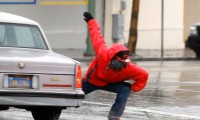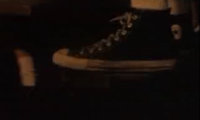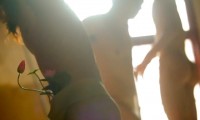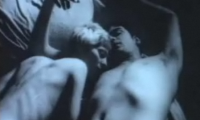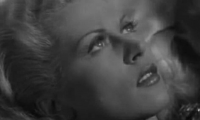The Sadies, The Beachland Ballroom, Cleveland, OH (March 1, 2008)
In college, I only danced when I was drunk, and my style could be best described with the phrase “clumsy, off-duty stripper” — all grinding, pelvic thrusts punctuated by an inevitable tripping over my own heels. I fell into people; I fell on the ground. Fortunately this is pretty acceptable behavior when you’re 17.
When I moved from Michigan to Chicago in the mid-nineties, I started going to see live music at small bars where no one danced, and I learned to stand in the international posture of aesthetic assessment — arms crossed, head barely nodding to beat — and I did my level best to achieve an aura of cool detachment, which I’d maintain until I (somehow, still) fell down.
Years later, I met my husband and I began to go see the band in which he plays drums, The Sadies, on an increasingly frequent basis. It’s been over ten years at this point, and the band’s style continues to evolve through various genres like garage, rockabilly, surf, bluegrass, and punk, with influences ranging from Clarence White to The Byrds to The Ramones to Lee Hazlewood to the 13th Floor Elevators, but from the beginning, the consistent emphasis has been on speed and musical proficiency rather than cultivated angst. I quickly learned to loosen my grip on my elbows, to stop thinking about the lyrics, to stop thinking at all. I started “dancing like an asshole,” as I would sheepishly concede the next day, my neck killing me from shaking my head like a maraca.
For a long time I was still drinking during these personal, off-stage performances, and this helped me set myself free — it didn’t hurt that the band’s audience was far less self-conscious and the atmosphere at their shows far more frenzied than what I’d been used to before.
When I quit drinking a few years ago, I was delighted to discover I still loved to, so to speak, fly my freak flag at the shows, even without any liquid lubrication. And I fall down a lot less, making moves like climbing onto a speaker cabinet to go-go dance with a girlfriend much safer.
Since I first heard about the United Society of Believers — or the Shakers, as they are commonly known — I have been curious about their obvious attachment to ecstasy despite the fact that they lived in celibate co-ed communities until they unsurprisingly petered out in the 20th century.
Sister Mildred Barker (1897-1990) singing “With A New Tongue” (from the 1974 film, “The Shakers” by Tom Davenport)
They were called Shakers because they shook their bodies in a wild — originally freeform and later structured — dance as part of their service. They were a millenarian group, believing that the end of the world was around the corner (isn’t it always?), and so they removed themselves from society — and from the reproductive cycle — as a means of embracing a spiritual regeneration.
The Sadies do a cover of the Mekons song “Memphis, Egypt,” a sardonic love song to rock and roll that challenges listeners to “destroy your safe and happy lives / before it is too late.” It’s rousing as hell and I go fucking bananas when they play it. I truly don’t care how insane I look, it’s too much fun to stop and worry about it.
The Mekons, “Memphis Egypt,” (1989)
I suspect that I seem less like a sex worker now and more like a Warner Brothers cartoon (I’m thinking of the Tasmanian Devil, but I feel like the Tex Avery–era Bugs might also dance like a lunatic given the chance.) I have long held that there is a direct link between the kind of communitarian, ecstatic experience of losing your shit at a rock show and the crazed mass worship practiced in the separatist religious movements that flourished in nineteenth-century North America.
The first time I went to see the Toronto band The Deadly Snakes, I felt like I had wandered into an old time revival tent. I mourned when they broke up.
Recently a friend who knew I was writing poems about the Shakers sent me a link to Dan Graham’s brilliant film, “Rock My Religion” (1984), as much a manifesto as it is a documentary that follows the thread that runs from anti-establishment religious groups like the Shakers and southern snake-handling sects straight through to Bo Diddley, Patti Smith, and Sonic Youth. The film is as unpredictable and charged with raw energy as its subject.
Watching it, I had that reaction that is a cousin to shame, a mix of excitement at the discovery and a nagging guilt that I didn’t already know the film intimately. Here it is in its entirety, thanks to Ubu Web (god bless Ubu Web, and yes, I just might mean that literally).
Dan Graham, “Rock My Religion” (1984)
Rock is often dismissed at first blush (or spit) as juvenile nihilism, and it’s true that at its least interesting, the genre stagnates in a shallow pool of narcissism and empty showmanship. But at its most interesting, rock music produces a derangement of the senses that is the closest I’ve come to experiencing an act of authentic, modern-day shamanism.
Of course, there are other musical genres that claim to deliver the same sensation — electronic dance music, from disco to rave to jungle, is an obvious example — but there’s something in rock’s defiant individualism and its relationship with the lyric voice that resonates with me. And I love watching human beings create layered waves of sound live and in real time through a display of incredible physical skill; like dance, it’s the application of pure athleticism to art.
Here is one of the poems I wrote about the Shakers:
DREAM OF THE LAST SHAKER
We stream into the meetinghouse
through two doors
like twin cords
in the same braid.
I love the men,
all of them
lined up like
God’s long finger.
The sun attends everything
equally: the wood, the bend
of her white muslin sleeve,
the outstretched arm of the apocalypse.
Take hold of my shoulder.
Shake me awake.
I recently read this at a public event and a young guy approached me and shouted, “‘The outstretched arm of the apocalypse’? What the hell is that?” At the time, I brushed him off — who wants to explain their work at an afterparty? — but what I might have said is that I can relate to the desire to view The End of Everything You Know as if it were approaching you like an immaculate lover.
“Destroy your safe and happy lives” is a tongue-in-cheek command to wake up to the world that exists beneath our daily somnombulance. It’s not the destruction of the known that I believe in, it’s the possibilities that open up in its wake that excite me. Controlled chaos is not only liberating, it’s transcendent.
Rock on.
– Damian Rogers
